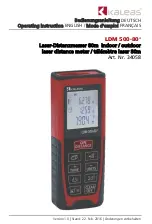
Model 6487 Reference Manual
Remote Operation
9-9
SPE, SPD (serial polling)
Use the serial polling sequence to obtain the Model 6487 serial poll byte. The serial poll
byte contains important information about internal functions. Generally, the serial polling
sequence is used by the controller to determine which of several instruments has requested
service with the SRQ line. However, the serial polling sequence may be performed at any
time to obtain the status byte from the Model 6487.
Front panel GPIB operation
The following paragraphs describe aspects of the front panel that are part of GPIB opera-
tion, including messages, status indicators, and the LOCAL key.
Error and status messages
for a list of error and status messages associated with IEEE-488 program-
ming. The instrument can be programmed to generate an SRQ and command queries can
be performed to check for specific error conditions.
GPIB status indicators
The REM (remote), TALK (talk), LSTN (listen), and SRQ (service request) annunciators
show the GPIB bus status. Each of these indicators is described below.
•
REM
— This indicator shows when the instrument is in the remote state. REM
does not necessarily indicate the state of the REM line, as the instrument must be
addressed to listen with REM true before the REM indicator turns on. When the
instrument is in remote, all front panel keys, except for the LOCAL key, are locked
out. When REM is turned off, the instrument is in the local state and front panel
operation is restored.
•
TALK
— This indicator is on when the instrument is in the talker active state.
Place the unit in the talk state by addressing it to talk with the correct MTA (My
Talk Address) command. TALK is off when the unit is in the talker idle state. Place
the unit in the talker idle state by sending a UNT (Untalk) command, addressing it
to listen, or sending the IFC (Interface Clear) command.
•
LSTN
— This indicator is on when the Model 6487 is in the listener active state,
which is activated by addressing the instrument to listen with the correct MLA (My
Listen Address) command. LSTN is off when the unit is in the listener idle state.
Place the unit in the listener idle state by sending UNL (Unlisten), addressing it to
talk, or sending the IFC (Interface Clear) command over the bus.
•
SRQ
— You can program the instrument to generate a service request (SRQ) when
one or more errors or conditions occur. When this indicator is on, a service request
has been generated. This indicator stays on until the serial poll byte is read or all
the conditions that caused SRQ have ceased to exist.
















































